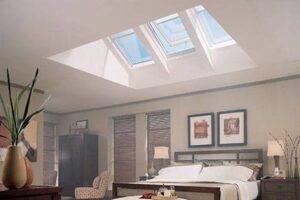Have you ever walked into a building and still had a view of the sky? Doesn’t the coffee taste just a little bit better when you can feel the sun gliding over you and warming you through the overhead window opening? If so, or even if you can just imagine experiences like these, you may be starting to think about the special magic of skylights. As part of a new roof installation or general home improvement, skylights are both functional and beautifying additions. Although skylights can be installed at any time, planning upcoming roof work or a new roof installation is an ideal time to revisit this addition to your home, since roofing specialists can also provide skylight guidance and installations.
As you consider the addition of a skylight, it is important to vet skylight contractors to ensure they have the knowledge and expertise to properly repair or install a new skylight. Additionally, as you consider adding a skylight, then it is worthwhile to learn about the potential benefits, along with the structural demands because they impact the scope of the project, along with the skylight installation and cost.
What is a skylight?

Structurally, a skylight is a window-like opening of various shapes and sizes and may be fixed, meaning permanently closed, or operable, in which case it can be opened or closed manually or remotely. The skylight’s glazing or lens is often made of glass or plastic, and the frame of the skylight may be made from wood, aluminum, vinyl, or fiberglass depending on the manufacturer and model. Metal or rubber flashing also accompany the skylight installation to ensure a watertight seal between the skylight and the roof. Skylights can also be customized with other features, such as motorized or solar-powered ventilation, smart home integration, rain sensors, or built-in blinds or shades.
Regarding where to put a skylight, multiple factors will impact the locations of any skylights and perhaps even the type of skylight. To learn more, the following questions will help determine the rooms in your home that may benefit from a skylight:
- As you are mindfully exploring each space, where is there a lack of natural light? Where is there a reliance on multiple lamps or overhead lighting?
- Relative to the purpose of a room, how could a skylight improve its function? For example, in a kitchen, an operable skylight could provide better overall visibility and be used to release cooking smells or heat.
- Are there any privacy needs to consider with regard to installation? For example, would people on a second floor be able to see into a first floor bathroom via a skylight? If so, reconsider skylight placement or investigate different glazing options to provide light without compromising privacy.
- If increasing your home’s worth is one motivator for skylight installation, in what room would a skylight provide an extra special touch to the space by way of illumination, views, or design?
- To help you anticipate the timing and presence of the sun in the room, how does the sun move over your home? What is the directional orientation of your home, and how and where might you orient potential skylights?
As you narrow down your skylight placements, discuss your wishes with roofing professionals, such as the Ranch Roofing team, so that they can evaluate your roof and other structural components to ensure safe skylight installation while maintaining the roof’s integrity. Like other roofing work, it is imperative to work with professionals to ensure the house remains structurally sound, along with obtaining the proper permits for any work. Professionals also have the expertise to recommend the proper lens and frame material. Plus, working with an experienced team offers additional benefits like understanding the durability or maintenance requirements. Finally, skylight pricing depends not only on the manufacturer and model, but also on the skylight’s dimensions, customization features, types of glazing, inclusion with or without a new roofing installation or additional skylights, and more.
What are the benefits of a skylight?

The primary purpose of a skylight is to invite natural light into any space, a function achieved regardless of whether or not the skylight opens. They are often added to rooms that may otherwise have few or no windows as a result of their location in the home, such as an interior hallway, or outside environment. This new light source often lends an increased feeling of spaciousness, an elevated aesthetic, and an additional source of warmth. In addition to the selection of an operable skylight, blinds or shades can be added to skylights to enable regulation of light or temperature control. For these qualities and any additional customizations, skylights also increase a home’s property value. Plus, depending on the type of skylight, some other functions and features include:
- Increase fresh air circulation
- Release accumulated moisture, hot air, or odors
- Improve energy efficiency
- Support overall health and mood
- Enhance ambience and functionality of indoor space and visual appeal of home’s exterior
- Add additional scenic views and opportunity to connect with nature
- May provide additional monetary benefits as with federal solar tax credit
Finally, in addition to providing an elegant look and open feel to any space, skylights increase the availability of natural light and offer many other practical benefits depending on the type of skylight selected. By understanding what a skylight is and why one or more should be incorporated into your home, you may be ready to take the next step by consulting professionals, like those at Ranch Roofing, for their expertise in selecting the best skylights for your home. For a free estimate or to discuss skylights for your home, call or contact Ranch Roofing today.
